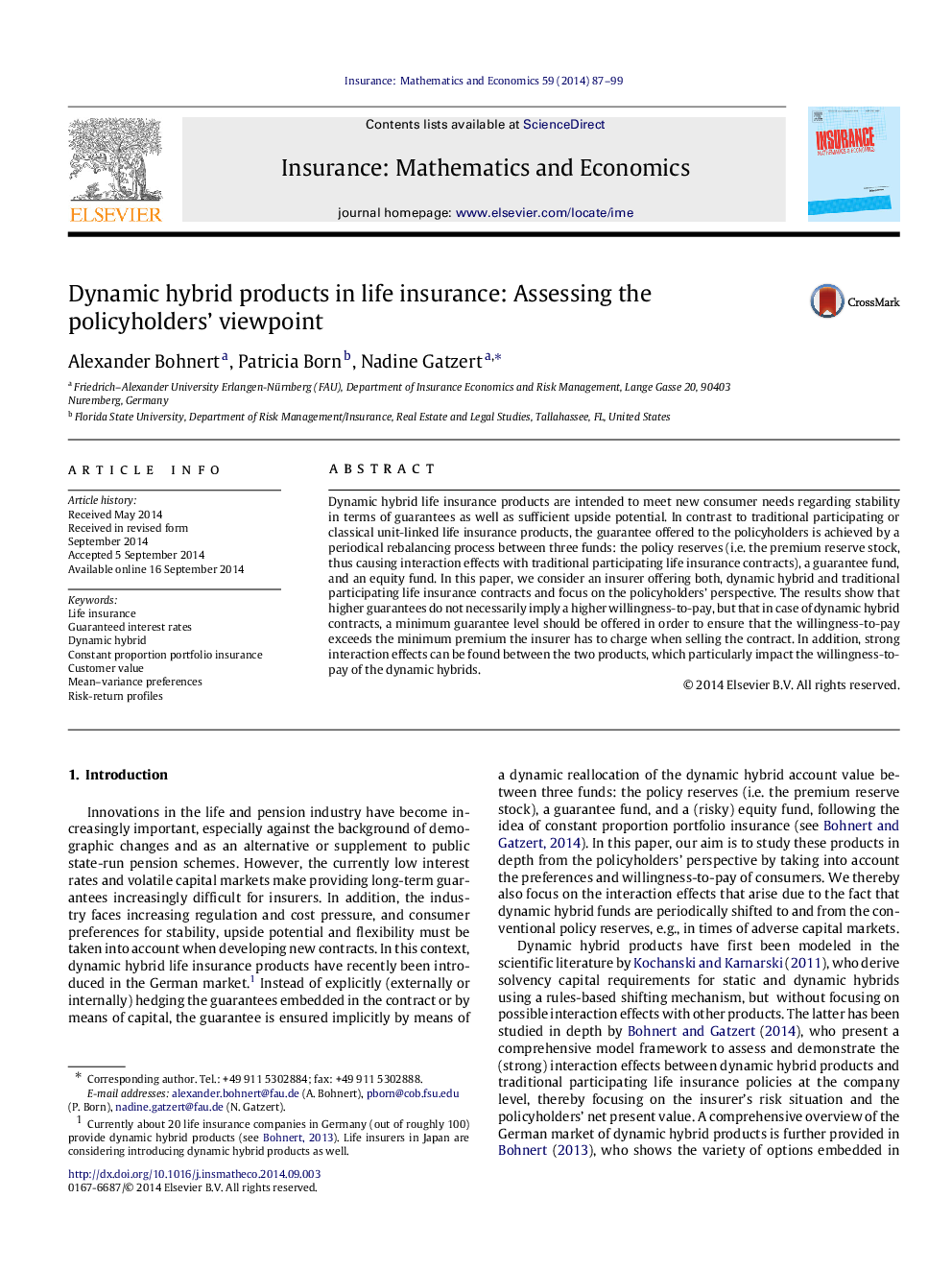| کد مقاله | کد نشریه | سال انتشار | مقاله انگلیسی | نسخه تمام متن |
|---|---|---|---|---|
| 5076597 | 1477216 | 2014 | 13 صفحه PDF | دانلود رایگان |
عنوان انگلیسی مقاله ISI
Dynamic hybrid products in life insurance: Assessing the policyholders' viewpoint
ترجمه فارسی عنوان
محصولات ترکیبی پویای در بیمه زندگی: ارزیابی دیدگاه بیمه گران
دانلود مقاله + سفارش ترجمه
دانلود مقاله ISI انگلیسی
رایگان برای ایرانیان
ترجمه چکیده
محصولات بیمه زندگی هیبریدی پویا در نظر گرفته شده برای دیدار با نیازهای مصرف کننده جدید در رابطه با ثبات از لحاظ تضمین و همچنین پتانسیل افزایش بالقوه کافی است. در مقابل کالاهای بیمه زندگی مرتبط با یکپارچه شرکت های وابسته و یا وابسته به کلاس های کلاسیک، تضمین ارائه شده به بیمه گذاران با یک روند متعادل سازی دوره ای بین سه صندوق به دست می آید: ذخایر سیاست (به عنوان مثال سهام ذخیره حق بیمه، قراردادها)، صندوق تضمین و صندوق سهام. در این مقاله، ما در نظر داریم یک بیمه گر، ارائه قراردادهای بیمه عمر شرکت های پویای هیبرید و سنتی را در نظر می گیریم و بر روی دیدگاه بیمه گران تمرکز می کنیم. نتایج نشان می دهد که تضمین های بالاتر لزوما به معنی تمایل به پرداخت بیشتر نیست، اما در مورد قراردادهای هیبریدی پویا، باید حداقل سطح تضمین ارائه شود تا اطمینان حاصل شود که تمایل به پرداخت بیش از حداقل حق بیمه بیمه گذار هنگام خرید قرارداد هزینه می کند. علاوه بر این، اثرات متقابل قوی می تواند بین دو محصول یافت شود، که به ویژه بر تمایل به پرداخت هیبرید های پویا تاثیر می گذارد.
موضوعات مرتبط
مهندسی و علوم پایه
ریاضیات
آمار و احتمال
چکیده انگلیسی
Dynamic hybrid life insurance products are intended to meet new consumer needs regarding stability in terms of guarantees as well as sufficient upside potential. In contrast to traditional participating or classical unit-linked life insurance products, the guarantee offered to the policyholders is achieved by a periodical rebalancing process between three funds: the policy reserves (i.e. the premium reserve stock, thus causing interaction effects with traditional participating life insurance contracts), a guarantee fund, and an equity fund. In this paper, we consider an insurer offering both, dynamic hybrid and traditional participating life insurance contracts and focus on the policyholders' perspective. The results show that higher guarantees do not necessarily imply a higher willingness-to-pay, but that in case of dynamic hybrid contracts, a minimum guarantee level should be offered in order to ensure that the willingness-to-pay exceeds the minimum premium the insurer has to charge when selling the contract. In addition, strong interaction effects can be found between the two products, which particularly impact the willingness-to-pay of the dynamic hybrids.
ناشر
Database: Elsevier - ScienceDirect (ساینس دایرکت)
Journal: Insurance: Mathematics and Economics - Volume 59, November 2014, Pages 87-99
Journal: Insurance: Mathematics and Economics - Volume 59, November 2014, Pages 87-99
نویسندگان
Alexander Bohnert, Patricia Born, Nadine Gatzert,
